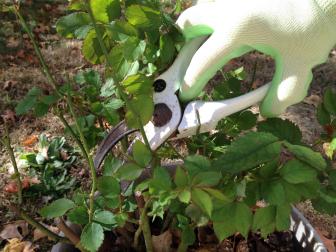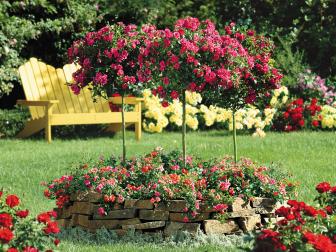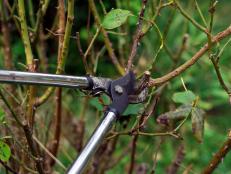How to Winterize Your Roses
Check out these tips on winterizing roses to get your roses through the cold season unscathed.

Some gardeners, even in the colder zones, wait to winterize roses until late fall when all the roses are completely dormant. But the weather is unpredictable by mid-fall, and a sudden cold snap could cause serious damage.
There's more than one method of winterizing all your roses. How your rose fares in winter depends on a number of factors — the weather, the plant's location in the garden and, of course, the type of rose. Some varieties are more naturally hardy than others. Temperate zones (USDA Zone 6 and warmer) are easier on roses, and roses planted close to the house are more sheltered than those out in the open. Check with your nursery or local rose society if you aren't sure whether your varieties are hardy. If there's a graft on your rose bush, it's a newer variety and probably not hardy.
Everything You Need to Know About Roses
Learn more about the flower that has inspired poets, painters, gardeners and crafters alike.
Tender varieties of roses can be seriously damaged in places where the temperatures dip below 20 degrees. But there's an easy way to protect them with a technique called the "Minnesota tip." It was developed in the 1950s by a Minnesota gardener and involves tipping a rose bush into a trench.
- Prune the bush to three feet tall, cutting above outward-facing buds. Remove smaller limbs, leaving three to five of the thickest, most vigorous canes.
- If there are any leaves, pull them off. Aside from harboring disease, leaves can increase drying.
- Tie the canes together using synthetic twine that will not decay over winter. Tie by starting at the bottom with a slip knot and lacing up the plant. Leave a long piece of twine attached.
- Spray the canes with dormant oil spray, which protects them from diseases in the soil. Mix 5 tablespoons of the oil with 1 gallon of water. Or, if you've already made a baking-soda solution (1/3 cup baking soda to 1 gallon water) to spray as a fungicide, you can simply add the dormant oil to that to save time. Coat the canes well and let dry.
- Dig a trench on one side of the plant and loosen the soil around the roots using a garden fork to minimize root damage.
- Add fallen evergreen needles to the trench and mix with the topsoil. The high acidity of evergreens is great for rose beds.
- Use a garden fork to pry under the roots and carefully tip the plant over into the trench.
- Cover the plant completely with the soil that was removed, being careful to leave the long piece of extra twine exposed above the dirt so it will be easier to find later.
- Water the bed to help settle the soil and keep the canes and roots in good shape for the winter.
- Cover with a carpenter's blanket and bags of leaves to keep it in place. Bags of leaves are easier to deal with in the spring than loose leaves, but for small areas loose leaves may be fine and will decompose.
This process can be used for all varieties of nonhardy roses — from standard to miniature. By early April when days are warmer and longer, remove the leaves, and then a few weeks after that, uncover the bush, untie it and get it ready for a summer of beautiful flowers.
If you live in a zone where the temperatures get cold but stay above freezing, you can use these steps for all of your roses. In the warmest areas, roses never go into complete dormancy, but they do stop blooming and need very little winter attention.
Many gardeners prune their roses heavily at this time so they won't interfere with spring growth, but pruning is a matter of personal preference. You can cut back the canes to two or three feet high and remove any problem branches. Most hardy roses come from Canada and are crown-hardy, which means that they can die back to the ground. In the spring, you can prune the dead wood above ground and the plant will come up again.
Pruning Roses During Winter
See why you should prune your roses when it's chilly outside.
Winterizing Hardy Roses
- Add a rose cone, which is available at garden centers.
- Poke holes for ventilation to prevent moisture buildup against the canes.
- Weigh the top down but leave it open.
- Push soil against cone to seal it. Once the shrubs are cut back, tie them with string. Wrap them in a circular way, just to keep them from being whipped in the wind.
- Mound the base of rose with 10 to 12 inches of soil. Get the soil from somewhere other than your bed. You don't want to be removing soil from the root base and exposing it to cold.
An alternative method for winterizing hardy roses is called collaring:
- Don't prune the top of the rose bush.
- Remove the leaves but not the hips.
- Tie up the bush with twine.
- Mound soil 10 to 12 inches around the base of the plant to insulate the crown.
- Surround the plant with a wire hoop to form a collar.
- Fill the collar with leaves to insulate the canes.
- For extra protection, wrap a piece of burlap around the collar and secure it with twine.
You might be tempted to add new roses to existing beds in the fall, but it isn't a good idea. New roses have to compete with older roses that have a stronger root base, so the new plants won't get the nutrition they need to grow strong. Prepare now for a new bed by loosening the soil and adding several amendments to the soil, such as coarse sand for better drainage, sphagnum peat moss for aeration and higher acidity, leaves and pine needles, blood meal, manure, cottonseed meal and gypsum (calcium sulphate). All of these materials will break down over winter, and in the spring your soil will be rich and you'll have one less task to do when you'd rather be planting.
More Advice on Growing Roses
16 Perennial Partners for Roses 16 Photos
Discover perennials that pair beautifully with roses in the garden.
10 Easy-to-Grow Climbing Roses 10 Photos
Plus, tips on training these disease-resistant climbers to adorn a trellis or wall with color all season long.
How to Grow Patio Roses in Containers
Plant roses in containers so you can stop and smell the roses on your patio, deck or balcony.


















































